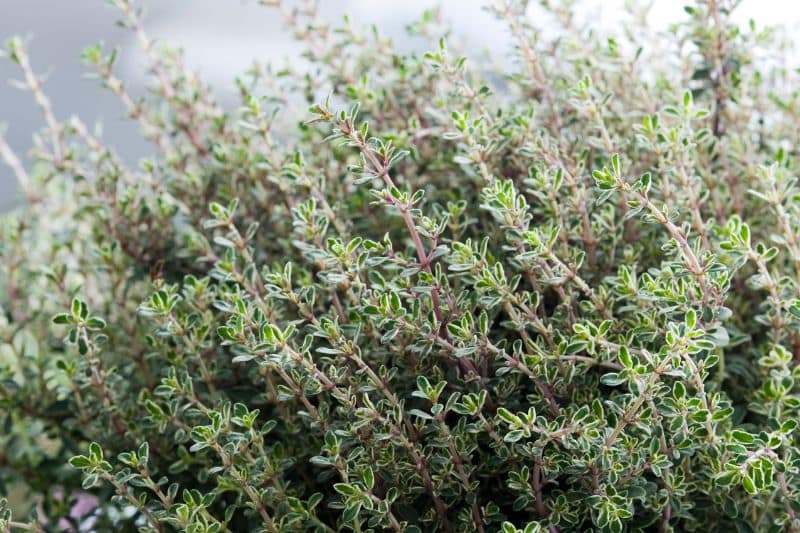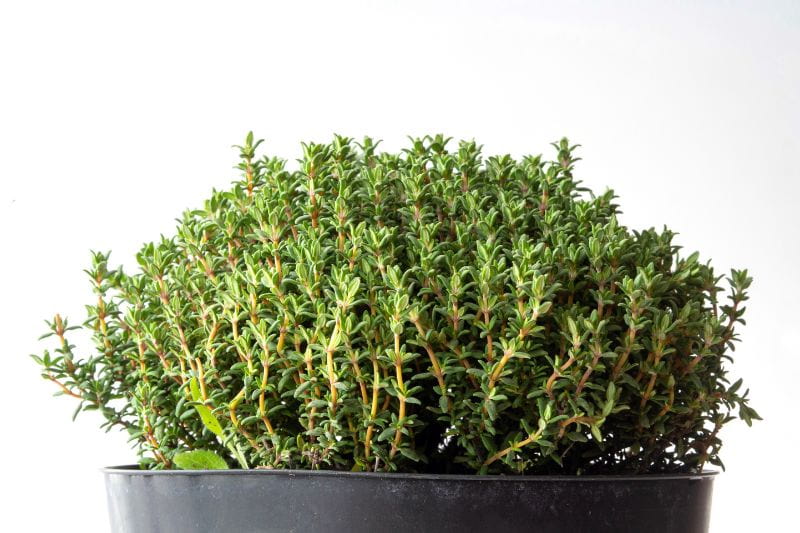Common thyme, lemon thyme, wild thyme, Corsican thyme... The aromatic, medicinal leaves of this perennial smell of the south. Essential in vegetable patch, or even grown in a pot on a balcony or terrace, thyme (Thymus) favours sun and warmth while being very hardy. In its first year, thyme forms a clump of small, well-branched stems bearing tiny evergreen leaves coloured bluish-green to silvery grey-green, which become woody and form wood over time. That is why propagation is essential to ensure longevity of thyme plants. Discover our advice and the different techniques to propagate thyme!
To learn all about thyme: Thyme: growing, planting, pruning

Dividing thyme
When thyme becomes bare and woody, it loses interest and aesthetic appeal. A rejuvenation is needed and the simplest way to renew and increase plants is by dividing the clump. Division encourages emergence of new leafy, fragrant shoots.
It is also an easy operation that requires no waiting time. It consists of separating the thyme rootball into several pieces which should be replanted immediately
Thyme is divided in spring, usually in April, when the thyme plant shows signs of awakening. This division can be done every three years.
Required equipment
- A garden fork (or digging fork) to lift the clump
- A hand cultivator to loosen soil
- A transplanting trowel to make holes
Method for dividing thyme
- Work soil where divided thyme plants will be installed by loosening it with the hand cultivator and weeding thoroughly
- Push the digging fork in all around the thyme plant to lift it gently
- Remove the rootball from soil without pulling too hard to avoid damaging the roots
- Remove soil stuck to roots and pull out weeds from the rootball
- Separate the clump into three distinct parts, each with roots, by pulling gently
- Replant pieces immediately into pre-dug holes, leaving only 10 cm of stems and leaves above soil
- Remove leaves from old clump to allow them to dry
- Water lightly.
You can also pot some of the thyme divisions to keep within easy reach on balcony or terrace. Simply plant thyme in a mix of potting compost and garden soil, or just in potting compost, after placing a good layer of clay balls at the bottom of the pot.
Afterwards, watering is unnecessary if thyme has been planted in ground — rain should do the job. However, thyme grown in a pot needs moderate watering once a week. Never leave water in the saucer!

Propagate thyme by cuttings
To increase thyme numbers, you can also propagate by cuttings. Propagation by cuttings involves taking stems from the mother plant and encouraging them to root before replanting. It is a method that takes a little time, but is generally successful. Moreover, it yields more plants than dividing clumps. Whatever cutting method is chosen, it takes several months to obtain a new thyme plant.
This operation is carried out in summer, generally from July to September, just after flowering.
There are three ways to take cuttings of thyme, but the first step is to take the stems that will be used for cuttings :
- Cut shoots of the year 10 to 15 cm long with a disinfected, sharp pruning shear
- Remove remaining leaves and flowers from lower part of stem, keeping leaves only on upper third
Your stems are ready to be propagated by cuttings.

Pot propagation by cuttings
Pot propagation is done undercover in a spot sheltered from wind, heavy weather and strong sun.
Required equipment
- Buckets, a seed tray, modules or a plastic bottle cut in half with holes in the base
- cutting compost or a mix of sand and garden soil
- A pencil
- Plastic bags
- Elastic bands or string
- A mister
Method for pot propagation by cuttings
- Fill chosen containers with substrate
- Make holes with the pencil every 5 cm and insert thyme stems leaving half the stem protruding
- Firm substrate around stems with fingers
- Mist lightly with the mister to moisten substrate (without saturating)
- Fix a plastic bag over the pot with elastic or string. If you used perforated bottles, simply place the top part back on without removing the cap (this step, which recreates mini‑greenhouse conditions with warmth and high humidity, is optional)
- Place cuttings in a warm, sheltered spot, protected from direct sun
Then, keep substrate constantly moist by misting regularly. After watering, replace plastic bag or bottle top. After a few weeks, stems will form new roots and small leaves. These should be potted on into buckets until planting out in ground in spring.
Propagation by cuttings in water
This cutting technique is by far the simplest since all you need is a glass of water!
- Place stems to be rooted in a glass of water at room temperature. Change water daily to avoid stagnation and rot
- Check often for small white rootlets. Discard stems that blacken
- When new fine roots are as long as the stem, you can pot up into buckets. This potting is delicate because rootlets are very fragile
- Fill buckets with fine compost, make a hole with the pencil and very gently place rooted thyme cuttings
- Do not firm down compost, but mist to moisten
- Place buckets in a cool, bright spot, out of direct sun.
Cuttings in buckets should be watered regularly but not excessively until planting out in ground in spring.
In-ground propagation by cuttings
This is not the easiest cutting method and success is not guaranteed. You need an area that is not too sunny and well sheltered.
- Work soil by loosening with a hand cultivator
- Weed thoroughly to remove all weeds and their roots.
- Rake out stones
- Add sand and a little compost or cutting compost if needed
- Make holes every 10 cm and insert stems halfway
- Press lightly with fingers to remove air pockets
- Place a plastic cloche over the cuttings
- Water regularly and ventilate during day by removing the cloche.
By following spring, cuttings will have grown enough to be transplanted to their final positions.
Propagation by sowing
Sowing thyme is possible. But the hardest part is collecting the seeds, which are tiny! Then you must be patient during germination phase, which can take two years. It is not a propagation method I recommend.
































Comments